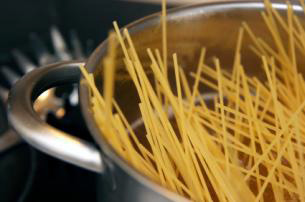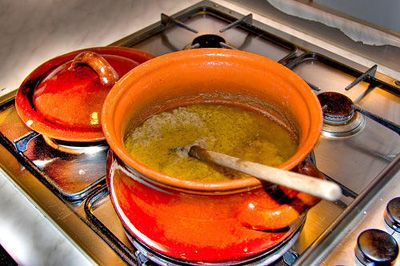 I have an open kitchen in our New York apartment. It’s perfect for me because I like to be at the party while I’m cooking—rather than boxed away in another room, away from the fun. I’m an actor, after all – an entertainer; I want to be part of the show, out in the light – not backstage
I have an open kitchen in our New York apartment. It’s perfect for me because I like to be at the party while I’m cooking—rather than boxed away in another room, away from the fun. I’m an actor, after all – an entertainer; I want to be part of the show, out in the light – not backstage
toiling in the dark.
However. There’s always some bozo – I’m sorry, did I say bozo? I meant some charming dinner guest – who comes over to shoot the breeze just when I’m about to perform a delicate, crucial step – like tasting the pasta for doneness. This is a holy moment, a private moment that demands the cook’s full attention and focus; because if the pasta goes past its moment – even just a few seconds past — it becomes a mass of wormy, mushy crap and you may as well toss it. But inevitably at that moment, as I’m fishing out that first, crucial strand to taste …
“So, Michael, two Jews go into a bar. You know this one?”
“Not right now.”
“Two Jews go into a bar. And the bartender … “
I make a rude, dismissive gesture with the back of my hand as I bite into the pasta with my dente. He responds by raising his voice.
“And one of them has a parrot on his shoulder. Did I say about the parrot?”
 And in my mind, I’m wishing I had a closed kitchen. With a lock on the door. And one of those bars that goes across. And a burglar alarm that goes directly to the police station. And a gun.
And in my mind, I’m wishing I had a closed kitchen. With a lock on the door. And one of those bars that goes across. And a burglar alarm that goes directly to the police station. And a gun.
Allora. What to do? I am two people: the convivial bon vivant, the mingler, the schmoozer; and the stand-offish prick who wants to cook perfect food for no one other than himself. And I have only one kitchen.
One kitchen and two personalities; what to do?
The answer, I believe, is antipasto. Get them to the table – around a big plate of irresistible food, get a knife and fork into their hands and a full glass of wine by their plate and then I will be free to noodle away at the stove for as long as I want and no one will pay me the least attention.
Antipasto is the key.
Peperoni in Bagna Cauda (Roasted peppers in hot anchovy sauce)
This antipasto dish is heaven; this is the mother-lode; I have seen people go into a trance over this – even people who would swear they don’t eat anchovies. It’s a peasant dish from the Piemonte in Northern Italy – the same region that gives us Barbaresco and Barolo … and don’t forget to put out some crusty bread for dipping. Ideally, you make this in an earthenware pot and have a warmer on the table so that the bagna cauda stays warm. If you have an old fondue pot from the Seventies, that’ll work. If not, this is a great reason to get one. Cooks disagree as to the ratio of oil to butter. It seems to depend on what village you come from. I think the butter should be subservient to the oil, but present. It adds a nice nuttiness to the sauce.
BAGNA CAUDA
¾ cup olive oil
3-4 tbsps butter
4 cloves garlic finely chopped
10 anchovies – preferably salt-packed and rinsed – chopped fine
salt (yes, salt – even though you’re already using anchovies)
Working over low heat, melt the butter into the oil. Add garlic and saute – but don’t let it brown. Add anchovies and stir, letting them dissolve into the butter, oil and garlic. Add a good pinch of salt. Keep warm but avoid more cooking.
ROASTED PEPPERS
I like the stove-top method for roasting peppers (I use a mix of red and yellow peppers). Just light all your burners to high and put a whole bell pepper on each. With tongs, keep turning them until they’re black. When each is done, put it into a paper bag. When they’re cool enough to handle,
peel off the charred skins, lose the seeds and the ribs and cut into nice bite-size pieces.
To serve: spear a piece of pepper on your fork (or use fingers), swirl it around in the hot anchovy sauce and put it on a chunk of bread. Then pop the whole garlicky, nutty, oily, buttery beauty into your mouth. Chew slowly and savor.
I like this with a prosecco or Champagne.
Michael Tucker is an actor and author whose third book is the recently published Family Meals: Coming Together to Care for an Aging Parent. You can read more about his food adventures on his blog Notes from a Culinary Wasteland.

